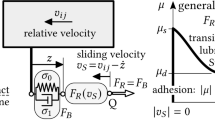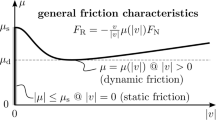Abstract
In this article, we study the dynamic behaviour of 1D spring-block models of friction when the external loading is applied from a side, and not on all blocks like in the classical Burridge–Knopoff-like models. Such a change in the loading yields specific difficulties, both from numerical and physical viewpoints. To address some of these difficulties and clarify the precise role of a series of model parameters, we start with the minimalistic model by Maegawa et al. (Tribol. Lett. 38: 313, 2010) which was proposed to reproduce their experiments about precursors to frictional sliding in the stick-slip regime. By successively adding an (i) internal viscosity, (ii) interfacial stiffness and (iii) initial tangential force distribution at the interface, we manage to (i) avoid the model’s unphysical stress fluctuations, (ii) avoid its unphysical dependence on the spatial resolution and (iii) improve its agreement with the experimental results, respectively. Based on the behaviour of this improved 1D model, we develop an analytical prediction for the length of precursors as a function of the applied tangential load. We also discuss the relationship between the microscopic and macroscopic friction coefficients in the model.














Similar content being viewed by others
References
Adams, G.G.: Self-excited oscillations of two elastic half-spaces sliding with a constant coefficient of friction. J. Appl. Mech. 62, 867–872 (1995)
Baumberger, T., Caroli, C.: Solid friction from stick-slip down to pinning and aging. Adv. Phys. 55, 279–348 (2006)
Baumberger, T., Caroli, C., Ronsin, O.: Self-healing slip pulses along a gel/glass interface. Phys. Rev. Lett. 88, 075509 (2002)
Ben-David, O., Cohen, G., Fineberg, J.: The dynamics of the onset of frictional slip. Science 330, 211–214 (2010)
Ben-Zion, Y.: Dynamic ruptures in recent models of earthquake faults. J. Mech. Phys. Solids 49, 2209–2244 (2001)
Berthoud, P., Baumberger, T.: Shear stiffness of a solid-solid multicontact interface. Proc. R. Soc. A 454, 1615–1634 (1998)
Bhushan, B.: Nanotribology and Nanomechanics. Springer, Heidelberg (2008)
Braun, O.M., Tosatti, E.: Kinetics and dynamics of frictional stick-slip in mesoscopic boundary lubrication. Philos. Mag. 91(24), 3253–3275 (2011)
Braun, O.M., Barel, I., Urbakh, M.: Dynamics of transition from static to kinetic friction. Phys. Rev. Lett. 103, 194301 (2009)
Braun, O.M., Peyrard, M.: Modeling friction on a mesoscale: master equation for the earthquakelike model. Phys. Rev. Lett. 100, 125501 (2008)
Brzoza, A., Pauk, V.: Torsion of rough elastic half-space by rigid punch. Arch. Appl. Mech. 78, 531–542 (2008)
Burridge, R., Knopoff, L.: Model and theoretical seismicity. Bull. Seismol. Soc. Am. 57, 341 (1967)
Candelier, R., Debrégeas, G., Prevost, A.: The role of exploratory conditions in bio-inspired tactile sensing of single topogical features. Sensors 11, 7934 (2011)
Carlson, J.M., Langer, J.S.: Properties of earthquakes generated by fault dynamics. Phys. Rev. Lett. 62, 2632–2635 (1989)
Filippov, A.E., Popov, V.L.: Modified Burridge-Knopoff model with state dependent friction. Tribol. Int. 43, 1392–1399 (2010)
Johnson, K.L.: Contact Mechanics. Cambridge University Press, Cambridge (1985)
Knopoff, L., Ni, X.X.: Numerical instability at the edge of a dynamic fracture. Geophys. J. Int. 147, 1 (2001)
Landau, L., Lifshitz, E.: Theory of Elasticity. Pergamon, New York (1986)
Maegawa, S., Suzuki, A., Nakano, K.: Precursors of global slip in a longitudinal line contact under non-uniform normal loading. Tribol. Lett. 38, 313–323 (2010)
Myers, C.R., Langer, J.S.: Rupture propagation, dynamical front selection, and the role of small length scales in a model of an earthquake fault. Phys. Rev. E 47, 3048–3056 (1993)
Nakano, K., Maegawa, S.: Stick-slip in sliding systems with tangential contact compliance. Tribol. Int. 42, 1771–1780 (2009)
Nielsen, S., Taddeucci, J., Vinciguerra, S.: Experimental observation of stick-slip instability fronts. Geophys. J. Int. 180, 697–702 (2010)
Olami, Z., Feder, H.J.S., Christensen, K.: Self-organized criticality in a continuous, nonconservative cellular automaton modeling earthquakes. Phys. Rev. Lett. 68(8), 1244 (1992)
Persson, B.N.J.: Sliding Friction. Springer, Heidelberg (2000)
Prevost, A., Scheibert, J., Debrégeas, G.: Effect of fingerprints orientation on skin vibrations during tactile exploration of textured surfaces. Commun. Integr. Biol. 2(5), 422–424 (2009)
Rubinstein, S.M., Cohen, G., Fineberg, J.: Detachment fronts and the onset of dynamic friction. Nature 430, 1005–1009 (2004)
Rubinstein, S.M., Cohen, G., Fineberg, J.: Dynamics of precursors to frictional sliding. Phys. Rev. Lett. 98, 226103 (2007)
Rubinstein, S.M., Cohen, G., Fineberg, J.: Visualizing stick-slip: experimental observations of processes governing the nucleation of frictional sliding. J. Phys. D 42, 214016 (2009)
Scheibert, J., Dysthe, D.K.: Role of friction-induced torque in stick-slip motion. Europhys. Lett. (EPL) 96, 54001 (2010)
Scheibert, J., Leurent, S., Prevost, A., Debrégeas, G.: The role of fingerprints in the coding of tactile information probed with a biomimetic sensor. Science 323, 1503 (2009)
Scheibert, J., Prevost, A., Debrégeas, G., Katzav, E., Adda-Bedia, M.: Stress field at a sliding frictional contact: Experiments and calculations. J. Mech. Phys. Solids 57, 1921–1933 (2009)
Scheibert, J., Prevost, A., Frelat, J., Rey, P., Debrégeas, G.: Experimental evidence of non-Amontons behaviour at a multicontact interface. Europhys. Lett. (EPL) 83, 34003 (2008)
Scholz, C.: The Mechanics of Earthquakes and Faulting. Cambridge University Press, Cambridge (2002)
Shaw, B.: Complexity in a spatially uniform continuum fault model. Geophys. Res. Lett. 21, 1983–1986 (1994)
Trømborg, J., Scheibert, J., Amundsen, D.S., Thøgersen, K., Malthe-Sørenssen, A.: Transition from static to kinetic friction: insights from a 2D model. Phys. Rev. Lett. 107, 074301 (2011)
Urbakh, M., Klafter, J., Gourdon, D., Israelachvili, J.: The nonlinear nature of friction. Nature 430, 525–528 (2004)
Wandersman, E., Candelier, R., Debrégeas, G., Prevost, A.: Texture-induced modulations of friction force: the fingerprint effect. Phys. Rev. Lett. 107(16), 164301 (2011)
Xia, K.W., Rosakis, A.J., Kanamori, H.: Laboratory earthquakes: the sub-rayleigh-to-supershear rupture transition. Science 303, 1859–1861 (2004)
Acknowledgements
We thank J. L. Vinningland for discussions. We acknowledge funding from the European Union (Marie Curie Grant No. PIEF-GA-2009-237089). This article was supported by a Center of Excellence grant to PGP from the Norwegian Research Council.
Author information
Authors and Affiliations
Corresponding author
Appendices
Appendices
1.1 Appendix A: Relative Viscous Damping in a Linear Chain of Blocks
If friction forces are ignored, the equation of motion for an infinite chain of blocks connected by springs is given by
We then assume a solution of the form
where \({\zeta_\kappa \in \mathbb{C}}\) and \({\kappa \in \mathbb{R}.}\) Inserting Eq. 23 into Eq. 22 yields the relation
which can be simplified to
since
The complex parameter \(\zeta_\kappa\) is then given by
The system is critically damped when Eq. 25 only has one solution for \(\zeta_\kappa,\) which occurs when the square root is zero:
The oscillations that are to be reduced have a wavelength λ = 2a, i.e. a wave number κ = 2π/λ = π/a. Inserting this into Eq. 28 leads to
which is the value of the damping coefficient η for which waves of wavelength λ = 2a are critically damped. Since the absolute value of \(\sin\) is always smaller than one, choosing \(\eta = \sqrt{km}\) will cause all other waves to be under-damped.
1.2 Appendix B: Tangential Force Profiles and Characteristic Length with a Tangential Stiffness of the Interface
An analytical expression for the characteristic length l 0 can be found. In order to do so, the following assumptions are made: N ≫ 1, l 0/L ≪ 1 and slow loading compared with the internal dynamics of the system, which enables a static analysis. The system is first placed in a static state with an initial tangential force profile given by τ 0 n , and then loaded slowly from the left. The equilibrium of all non-edge blocks writes
We introduce a new variable u n ′ defined by
where u 0 n is the initial position of block n. Inserting Eq. 31 into Eq. 30 yields
where
The two terms τ 0 n and \(-k_{\rm{t}} \left( u_n^0 - u_n^{\rm stick} \right)\) cancel in Eq. 32 since the initial state is static, and thus
The above equation can be rewritten to
where a = L/(N − 1) is the lattice spacing. Since N ≫ 1, the first term in Eq. 35 can be replaced by the second spatial derivative, and replacing u n ′ with u′(na) = u′(x) yields
which has the general solution
The tangential force is given by
By replacing again finite differences with second-order derivatives,
the general expression for the shear force profile can be found by using Eq. 37, which yields
The system is loaded from the left, and at the beginning of an event the tangential force on block 1 is equal to the static friction threshold μs p 1. Provided l 0/L ≪ 1, the trailing edge will not be affected by the loading. The latter of these two boundary conditions yields
i.e. A = 0. The first boundary condition yields
and the tangential force is therefore given by
The characteristic length l 0 is given by Eq. 37, and inserting for k given by Eq. 4 and a yields
and hence Eq. 12 for N >> 1.
Note that in a 3D situation, the exponential decay of the tangential stress with x would be replaced by a power law [9, 18].
1.3 Appendix C: Derivation of the Prediction of Precursor Lengths in Our Improved Model
We start with Eq. 16 and use the assumed tangential force profile in Eq. 21, shown in Fig. 14. Again, we go to the limit \(N \to \infty,\) resulting in the substitution
The tangential force after a precursor of length L p is then given by
We limit ourselves to predicting the precursors in Fig. 13b, i.e. using a tangential interfacial stiffness and linear initial tangential forces as depicted in Fig. 13a, but with θ = 0. The normal and initial tangential force are then given by
where the parameter β determines the slope in the initial tangential force profile. Inserting Eqs. 51 and 52 into Eq. 50 yields
The above integrals can be calculated easily, and the result is the tangential load F T as a function of the precursor length L p:
We observe that again F T(L) = μk F N.
Rights and permissions
About this article
Cite this article
Amundsen, D.S., Scheibert, J., Thøgersen, K. et al. 1D Model of Precursors to Frictional Stick-Slip Motion Allowing for Robust Comparison with Experiments. Tribol Lett 45, 357–369 (2012). https://doi.org/10.1007/s11249-011-9894-3
Received:
Accepted:
Published:
Issue Date:
DOI: https://doi.org/10.1007/s11249-011-9894-3




